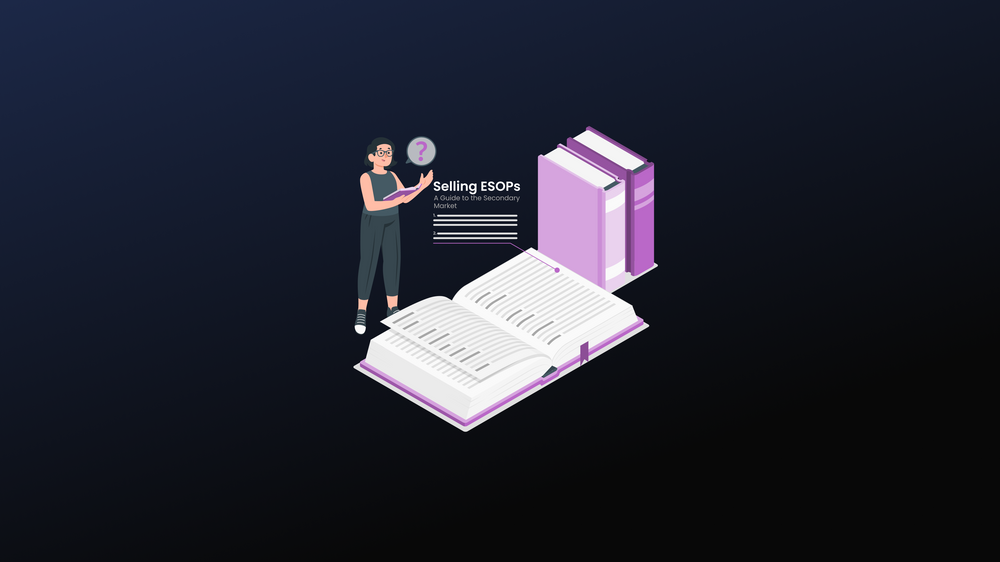Guide to Selling ESOPs or Shares on the Secondary Market
TL;DR: If you're an entrepreneur or an employee holding Employee Stock Options (ESOPs) or shares in a growing company, and you are considering selling them on the secondary market, this blog post is for you! We will guide you through the step-by-step process of selling ESOPs or startup shares in the Indian secondary market. Before proceeding, it's essential to understand the tax implications and choose the right platform for a smooth and hassle-free experience.
Introduction:
Are you an entrepreneur or an employee of a growing company who owns Employee Stock Options (ESOPs) or shares? If so, you probably understand that liquidity in the form of an IPO or buyback is uncertain, and might be considering selling them on the secondary market instead. In this post, we'll take you through the step-by-step process of selling ESOPs or startup shares in the Indian secondary market. Let's get started!
Before we begin, do understand that this post covers only ways to sell equity in unlisted startups and not deemed to be public companies i.e., private companies that have filed their DRHP (Draft Red Herring Prospectus) for an IPO. That is a subject we will cover in a different post.
Steps to sell your ESOPs/Shares:
If you already have shares and are looking to sell them, skip to step 4.
Step 1: Get stock of your vested options
If you plan to get liquidity for your ESOPs, it is important to understand that ESOPs are not tradeable or transferable. However, vested options can be exercised and sold. Hence, it is important to know how many stock options you have.
Step 2: Understand the exercise/strike price
Your ESOP grant should define the strike price at which you can convert your stock options into actual shares. This price could either be pre-defined or based on the fair market value (at par or at a discount) of the share on the day that you exercise it. For pre-defined strike prices, it can either be at face value or at a specific price.
Step 3: Know your tax treatment
Before proceeding with selling your ESOPs or shares, it's crucial to understand the tax implications involved, including the one-time perquisite tax. Different tax rules apply based on the holding period and the type of shares you possess. Long-term capital gains tax may be applicable if you hold your shares for more than 24 months, while short-term capital gains tax might apply if you sell them within 24 months. Additionally, you should be aware of any one-time perquisite tax that might be levied on the value of your vested options or shares at the time of exercise.
Step 4: Exercise your ESOPs
The process for this generally includes reaching out to the company and expressing intent to exercise your options. A board meeting would follow, wherein the company would pass a resolution to allow you to exercise the options and add you to their shareholder registry.
Step 5: Find takers for your equity
This is generally the hardest part. Trying to sell your equity in your startup doesn’t really make for great family dinner conversations, but perhaps you might have someone in your circle looking to be a shareholder in your startup.
Step 6: Try a Secondary Market Platform
In India, the secondary market for startup equity has been run by large private equity firms that require a minimum lot size available for sale. And this means, you’re probably going to find it hard to work with a traditional PE firm that can take on a small lot size. Another great new alternative is secondary marketplace platforms like Incentiv which allows smaller lot sizes and far less paperwork. A few important things to look out for while picking a secondary market platform are user-friendliness, security measures, and fees associated with the transactions.
Step 7: Decide your selling price
Secondary market deals usually happen at a discount. So, make sure to keep the price appropriate to ensure that you get takers for your sale and the platform usually takes care of the rest.
Step 8: Transfer of Shares and Payment
After finalizing the deal, intimate the company about your intent to sell. Private companies usually have a right of first refusal (ROFR) clause in place that allows the company to buy the shares before any third party. If the company does not buy it back from you and instead waives off the ROFR, a share transfer agreement i.e., SH4 is created between the buyer and the seller, post which the company files a board resolution to add the new shareholder to the shareholding document.

Conclusion:
Selling ESOPs or shares on the secondary market can be a rewarding experience, allowing you to unlock the value of your ownership in a growing company. However, the entire process can be tedious. It is hence extremely important that you pick the right platform so that the entire process can be smooth and hassle-free.



